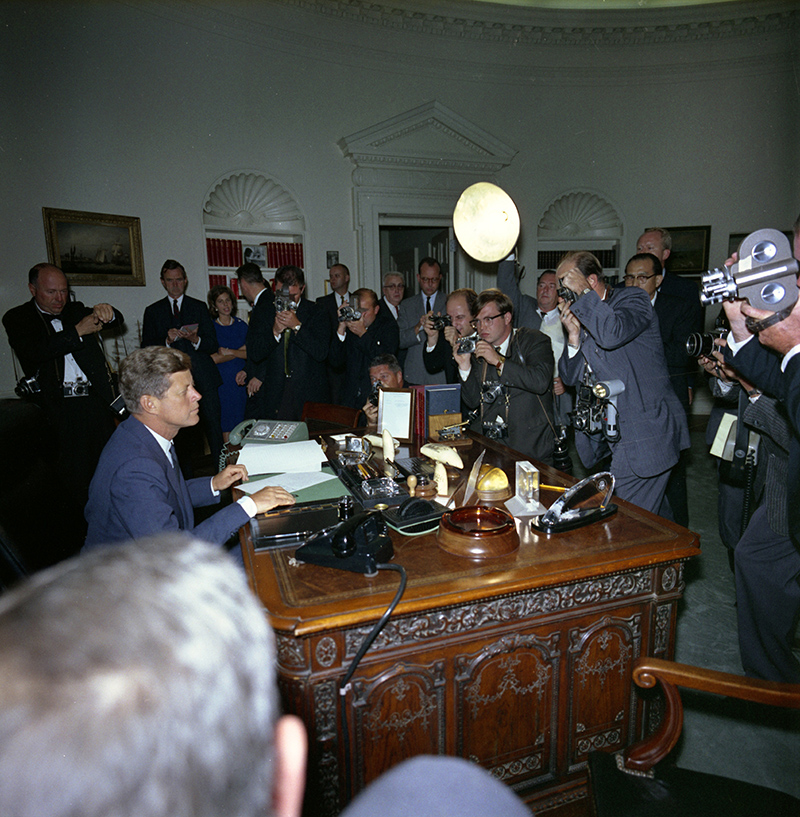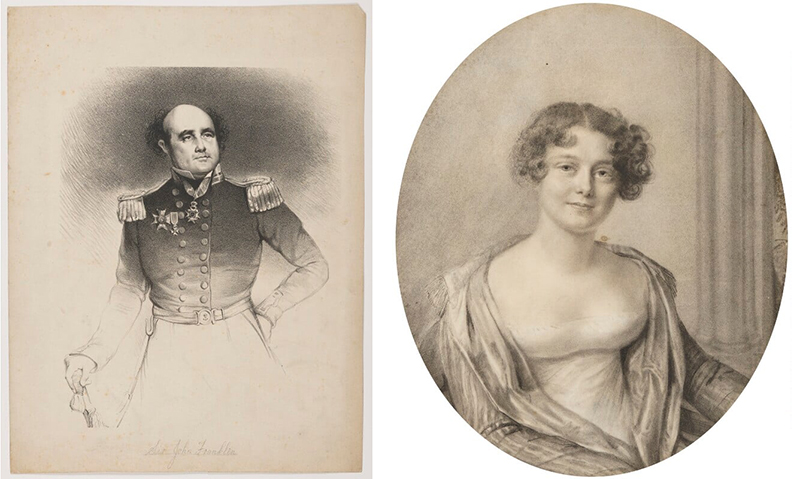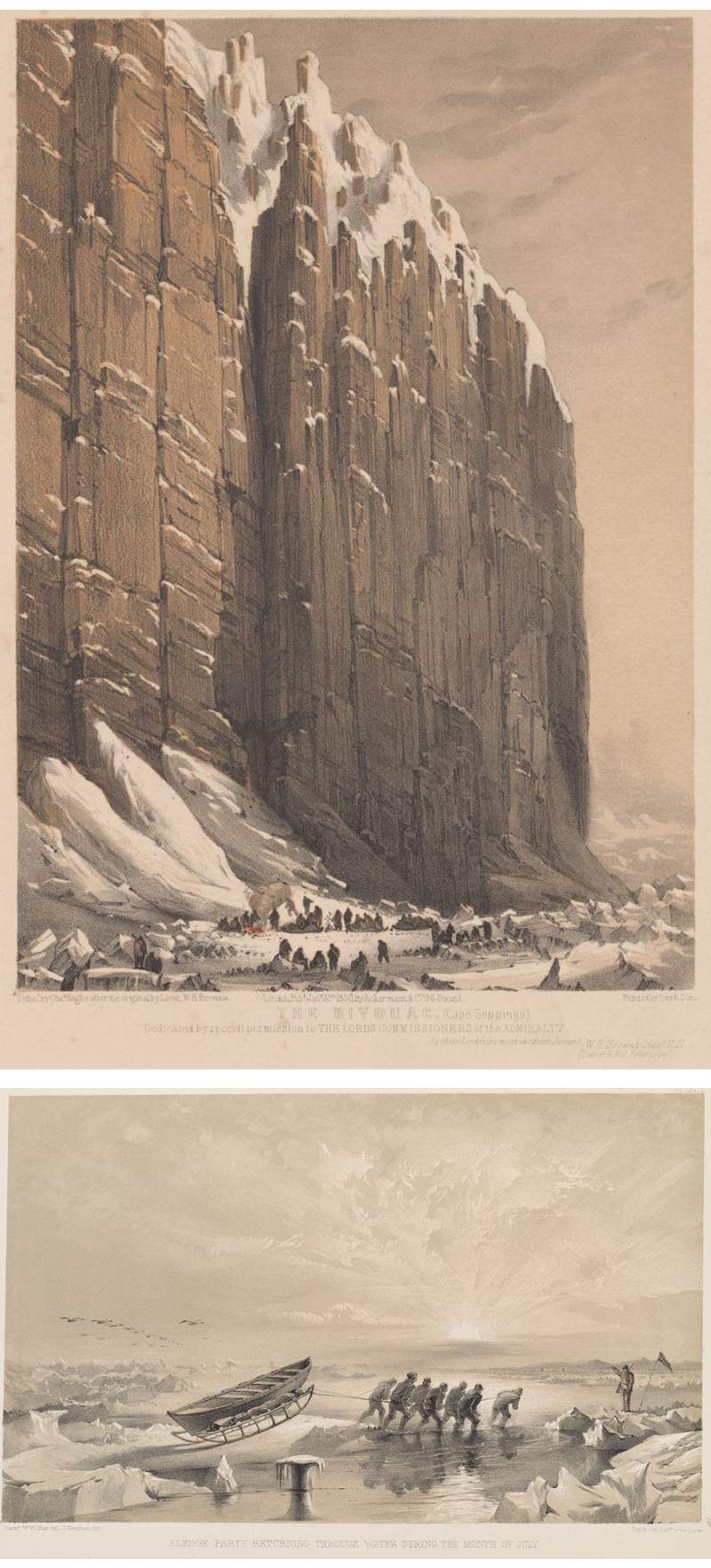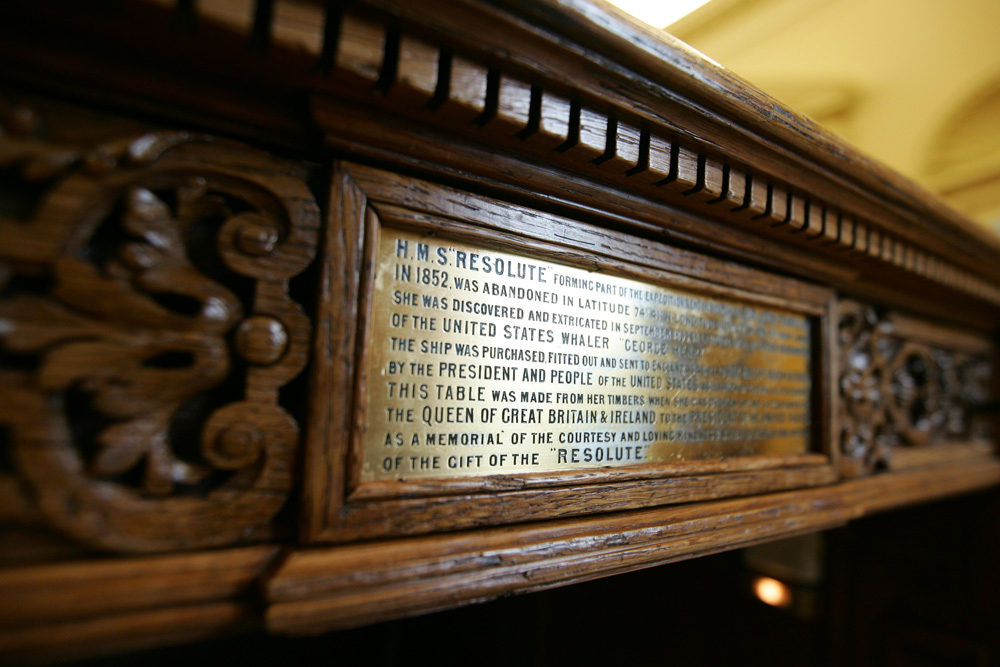The Symbol of Failure in the Oval Office
The Resolute Desk at the White House during the Grover Cleveland administration, 1886. [Wikimedia Commons]
Many presidents, including the current one, have used the Resolute Desk as their principal desk at the White House since it arrived at the mansion in the late 19th century, especially after John F. Kennedy first installed it in the Oval Office in 1961. Of those who have relied upon it, three have been assassinated and two others suffered assassination attempts. Two were impeached, one suffered a debilitating stroke in office, one suffered from dementia and died never remembering being president, and half a dozen lost bids for a new term as president. A superstitious observer with knowledge of the desk’s full history might wonder if any of them would have used the Resolute Desk had they known of its link with failure and death.
These presidents may have known that the desk was gifted to President Rutherford B. Hayes by England’s Queen Victoria in 1880, and that it was made from English oak salvaged from British naval ship H.M.S. Resolute. Few, if any, would have guessed that it could have been foisted on the U.S. by Britain’s Prime Minister Benjamin Disraeli as a sly joke.

The backstory of this possibly back-handed gift is a long and winding tale. The Resolute was acquired by the British Royal Navy in 1850 for use in its search for the missing Arctic expedition led by Rear Admiral John Franklin. Before he went missing on the last of his three far from spectacular Arctic explorations, Franklin had been known in Britain as “the man who ate his boots,” after surviving the failed “Coppermine” expedition that took the lives of half the men under his command in 1821. In the British tradition of rewarding glorious failure, Franklin was knighted in 1829.
In 1836, he was appointed lieutenant governor of the remote British penal colony of Van Diemen’s Land, today’s Australian island state of Tasmania. Franklin, still hankering for adventure, spent part of his time there exploring the mountainous island’s vast wilderness. His second wife, Lady Jane, accompanied him on his rambles, sometimes carried in a sedan chair by convicts.
At Lady Jane’s request, Franklin had a roughly 9-year-old Tasmanian Aboriginal boy, Timemernidic, sent 250 miles from the Wybalenna Aboriginal settlement on Flinders Island to Government House in Hobart Town. Lady Jane, who had no children of her own, had decided to foster the boy. Within 18 months she sent him away again, claiming him unruly. Timemernidic was later placed aboard a government vessel as a 12-year-old seaman. After the ship sailed for England, Timemernidic disappeared from the record. By 1841, Lady Jane had replaced Timemernidic with a 6-year-old Aboriginal girl, Mary, separated from her family on Flinders Island. Renaming her Mathinna, Lady Jane found the girl a much more pliable foster child. Mathinna attended lessons at Government House with Lady Jane’s teenage stepdaughter Eleanor, rode in the governor’s carriage with her foster mother, and had her portrait painted by a leading Hobart artist.
Sir John Franklin hosted the leaders of several expeditions at Government House as they traveled to and from Antarctica, which lay about 1,600 miles to the south of Tasmania. They included French explorer Captain Dumont d’Urville, and British explorers Captain James Clark Ross and Captain Francis Crozier, the latter pair carrying out explorations in H.M.S. Erebus and H.M.S. Terror. To Franklin’s delight, Ross and Crozier sojourned in Hobart several times, and like D’Urville, provided him with the sort of scientific conversation he sorely missed. After lashing Erebus and Terror together in Hobart’s harbor in June 1941, Ross and Crozier invited the wealthy free settlers of Van Diemen’s Land aboard for the most unique ball many would experience.
Sir John eventually lost interest in administering the colony; British settlers and Franklin’s secretary eventually complained to London that Lady Jane was running a “petticoat government.” Franklin’s gubernatorial tenure was cut short in 1843 when he was recalled to England. Before the Franklins departed Hobart, they dumped Mathinna in the local government orphanage; she would die within a decade.
Franklin, now promoted to rear admiral, volunteered to lead a new British attempt to discover the fabled Northwest Passage between the Atlantic and Pacific Oceans. He was almost 60, corpulent, and had a concealed lung condition typified by a chronic hacking night cough — as revealed by his daughter Eleanor in her letters home from Van Diemen’s Land. Franklin had last ventured to Arctic climes two decades earlier. Several other candidates, including Captain (by then Sir James) Ross, turned down the post. In February 1845, Franklin was given the job.
For the mission, Franklin was outfitted with two ships he knew well, Erebus and Terror, with Captain Crozier as his deputy. Before the expedition sailed from Kent in May 1845, Lady Jane boarded her husband’s flagship Erebus with Neptune the Newfoundland dog, Jacko the monkey and an unnamed cat for the crew, plus a professional photographer. Directing the taking of photographs of senior expedition officers she distributed to the press the resulting daguerreotype pictures, the last images recorded of these men, to promote her husband and his expedition. Lady Jane Franklin knew how to harness publicity.
In fact, it could be argued that without Lady Jane’s subsequent determination to promote her quest to find her missing husband once his expedition disappeared, there would be no Resolute Desk today.

Franklin’s expedition was last seen by Europeans in Baffin Bay, where whalers spotted his ships in July 1845. After two years passed without word from Franklin, Lady Jane pressed the British government to search for her husband and his 128 officers and men. The government declined, declaring Sir John had three years’ worth of tinned provisions with him and would be just fine.
In 1848, with still no news of the Franklin expedition, the government finally initiated a search. That spring, three parties went in quest of the lost expedition, one on land, two at sea — Sir James Ross commanding one of the latter. When these searches found nothing, the government offered a £20,000 reward to anyone who located Franklin’s party.
The following year, Lady Jane, convinced that Sir John was stranded and awaiting rescue, consulted clairvoyants, wrote to the press and government repeatedly, and urged whaling captains to search for her husband. She also wrote to U.S. President Zachary Taylor begging for help. American ship owner Henry Grinnell offered two ships for a search, on condition the U.S. Navy crew them. Taylor put this to Congress, which accepted Grinnell’s offer in January 1850. The Navy-crewed ships, commanded by Lieutenant Edwin J. DeHaven, conducted a search of Arctic waters without finding a trace of Franklin. After President Taylor abruptly died in office that summer, official U.S. search efforts ended. Lady Jane funded seven searches herself over the next decade, first paying a whaling captain £500 to search Baffin Bay.
Meanwhile, William Parker Snow, a sailor turned innkeeper in Melbourne, Australia, relocated to New York, working there as a journalist. In early 1850, probably inspired by press reports of Lady Jane’s employment of two clairvoyants — who both told her Sir John was still alive — Snow wrote to Lady Jane that he’d had a vision that revealed her husband’s location. With Snow proposing a search plan, Lady Jane invited him to England. She made him second-in-command of a search that would be conducted in a boat she purchased for the purpose and renamed Prince Albert. When a member of the public told Lady Jane that his deceased daughter’s ghost had revealed Sir John’s whereabouts, she rushed to pass this information to Snow and his commander. The Prince Albert’s subsequent search yielded no result.
Where did Lady Jane obtain the money for these ventures? She did receive public donations, including more than £1,500 from British settlers in Van Diemen’s Land. But she also went behind her stepdaughter’s back to open her missing husband’s sealed will. To Lady Jane’s fury, Sir John had made his daughter his principal heir. Eleanor had also been left a large sum by her late mother, Sir John’s first wife, Eleanor Porden Franklin, a noted poet who’d had a rich father.
Some modern sources politely refer to Eleanor’s inheritance being “waived” to permit Lady Jane to finance continued searches for Sir John. In reality, Lady Jane covertly plundered her stepdaughter’s inheritance, leading to an acrimonious split between the two women once Eleanor found out. The now-married Eleanor and her husband, the Reverend John Gell, were forced to take out a legal injunction to prevent Lady Jane drawing more checks on the inheritance. Eleanor eventually allowed her stepmother to put two-thirds of the interest from her inheritance toward searches for her father — but only on searches sanctioned by the government.

H.M.S. Resolute first entered the story in 1850, when it was one of several government and private vessels that unsuccessfully searched Arctic waters for Franklin’s expedition. In 1852, the British government bowed to renewed public pressure inspired by Lady Jane and sent Captain Edward Belcher to find the Franklin expedition with a five-ship squadron that included the three-masted barque Resolute. Instead, four of Belcher’s ships, including Resolute, became trapped in ice and were abandoned in 1854. Belcher, court-martialed for incompetence for losing his ships, was found not guilty.
Britain made no attempt to salvage the lost ships in the spring melt of 1855. That September, James Buddington, captaining the American whaler George Henry, found Resolute drifting off Baffin Island. He claimed Resolute for salvage and sailed her to New London, Connecticut. Congress appropriated $40,000 to buy the Resolute from him, with plans to refit the ship and return it to Britain as a goodwill gesture. In December 1856, the U.S. Navy sailed her to the Isle of Wight, where Queen Victoria had a holiday home, and presented the ship to Her Majesty. Resolute resumed Royal Navy service, but never again left home waters.

In 1854, the first news of the missing Franklin party’s fate emerged. Taken from first-hand statements by Inuit people recorded by Hudson Bay Company official John Rae, who had previously helped lead the 1848 overland search for Franklin, these accounts indicated the expedition’s last, starving survivors had resorted to cannibalism. Later scientific research on recovered remains would confirm Rae’s report. In 1859, a note by Franklin expedition officers was discovered in a stone cairn on a Canadian Arctic shore. It revealed that Sir John Franklin had been among the first to die, in June 1847, after Erebus and Terror had been trapped in ice and abandoned. This revelation terminated the official search for the Franklin party.
In 1860, Franklin’s daughter Eleanor caught a fatal case of scarlet fever while tending to her sick children during a holiday in Wales. She was only 36. Her estranged stepmother Lady Jane lived to 83, dying in 1875.

H.M.S. Resolute was decommissioned in 1879. On the instructions of the new government of Prime Minister Benjamin Disraeli, the Admiralty advertised a design competition for a piece of furniture made from Resolute’s timbers. Queen Victoria would present the furniture to American President Rutherford B. Hayes as a token of friendship between their two nations.
This competition was unlikely to have originated with First Lord of the Admiralty W.H. Smith M.P., a bookseller appointed to his post by Disraeli. Smith was so clueless about the Royal Navy that Gilbert and Sullivan savagely satirized him in their operetta H.M.S. Pinafore as Joseph Porter, an inept First Lord of the Admiralty who had never been to sea and gained high office through sycophancy. Smith was soon being called “Pinafore Smith,” even reputedly by Disraeli.
The idea for the royal gift of furniture, which had to be approved by the prime minister anyway, almost certainly originated with Disraeli. Relations between Britain and the United States had grown dangerously tense in the years after the American Civil War. Leaders in Washington demanded that Britain pay reparations for damages caused by warships that Britain had allowed the Confederacy to build in England during the war. Those reparations were eventually paid under the 1871 Treaty of Washington, with the amount of $15.5 million agreed upon in September 1872 after lengthy arbitration in Geneva, Switzerland.
Many British elites, including then-Leader of the Opposition Benjamin Disraeli, were not thrilled by the Treaty of Washington’s terms. To them, the concessions represented an enormous dent to Britain’s international prestige. According to London’s Daily News in 1871, “The arguments by Mr. Disraeli showed the moral impossibility of England submitting to contingent liability.” Those arguments by Disraeli were for not paying America reparations. Disraeli didn’t overtly criticize the U.S. government for aggressively pursuing reparations, but behind the scenes he was furious with then-prime minister William Gladstone for agreeing to them. Disraeli, who was also a famous novelist with a notoriously biting wit, said of his chief political opponent on one occasion, “If Gladstone fell into the Thames, that would be misfortune; and if anybody pulled him out, that, I suppose, would be a calamity.”
It is entirely possible that Disraeli, after being re-elected as prime minister in 1878, saw an opportunity to give Americans a subtle, ironic, poison chalice of a gift, as a personal salve to the Treaty of Washington’s sting. The Resolute Desk represented multiple failed attempts to rescue a failed expedition headed by a failed leader. It was, in effect, the very embodiment of failure.

One of the saddest stories involving the desk relates to the fate of the man who made it. The English firm that submitted the winning design for the desk, Morant, Boyd, and Blandford, became famous for several items of furniture it produced from Resolute timbers including the desk for President Hayes. But in 1896, 16 years after the Resolute Desk was delivered to the White House, the master craftsman who physically made it, William Evenden, died by suicide. According to his great-great granddaughter, 68-year-old William was in dread of being unemployed at the time.
In yet one more twist to the Franklin tale, one of the parties looking for his expedition in 1850, led by Commander Robert McClure, stumbled on what appeared to be the Northwest Passage. After McClure and his crew abandoned their icebound ship, H.M.S Investigator, they crossed the ice-covered passage on foot before being rescued by the ship that was taking the Resolute’s crew back to England. In 1903-06, Norwegian explorer Roald Amundsen would be the first to sail through the Passage and prove its existence. In 1911, Amundsen would also beat British explorer Captain Robert Falcon Scott to the South Pole, by less than five weeks. Scott, who perished with his men on the return journey, was nonetheless subsequently celebrated widely in Britain — yet another glorified British failure in the Franklin tradition.